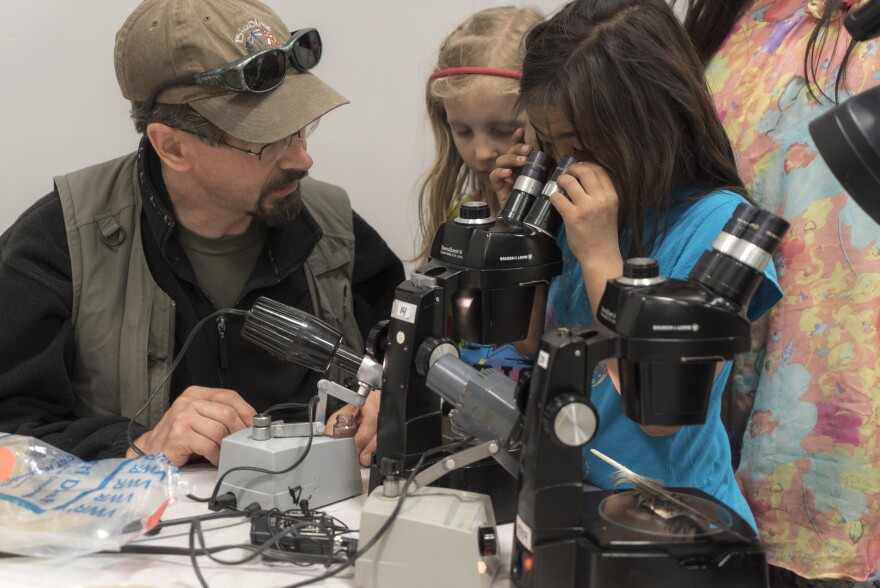Last week a group of scientists traveled to a small village in the Arctic to find as many different species as they could. It was happening all over the country in celebration of the 100th anniversary of the National Park Service. But it had special meaning in Anaktuvuk Pass, where the local Inupiaq people live a subsistence lifestyle inside of a national park.
It was warm and sunny when we left Anaktuvuk Pass early in the morning. We headed toward Blueberry Hill, walking through soggy tundra and patches of snow.
Soon the village disappeared and we were surrounded by an amphitheater of mountains.
Suddenly there was something fluttering around our feet. Kyndall Hildebrandt lunged after a small flying creature. She cupped her hands over a patch of tundra and peeked underneath.
It was a brown butterfly, an exciting catch even though she was actually looking for voles. She had set over a hundred mouse traps in two days, smearing them with peanut butter and setting them near the openings of small holes in the tundra.
“It’s the Snicker bars of the animal kingdom so everybody eats them,” Hildebrandt said. “So if there’s a lot of voles then you know there’s gonna be a lot of happy eagles and a lot of happy foxes.”
Hildebrandt is a small mammal researcher at the University of Alaska Fairbanks Museum. She’s one of 25 scientists and volunteers trying to find as many living things as they can in the dirt, mountains, and ponds around town.
Jeff Rasic works for Gates of the Arctic National Park.
“Wilson’s warbler, raven, Savannah sparrow, glaucus gull, american tree sparrow, orange crowned warbler, fox sparrow, white crowned sparrow,” Rasic said as he read off some of the species in the park.
Rasic organized the event to get a snapshot of what’s happening in the Arctic and to get the community involved in science. It’s called a Bio Blitz.
“It’s a scavenger hunt,” Rasic said. “Let’s tally up as many things as we can in a short amount of time: birds, plants, small mammals, large mammals if we happen to see them, fish.”
While spring is well underway in most of the country, it’s a little early in the Arctic. So the species tended to be pretty small.
Among the species were slimy sculpin, wolf spiders, glacier avens, flower, snowshoe hair, singing vole, arctic ground squirrel, etc.
After tramping through the park with nets, Ziploc bags, and binoculars, scientists returned to the Nunamiut school with backpacks full of samples. They set up tables in the gym and covered them with fox skulls, bird wings, and various types of scat.
The brown butterfly we had found on the hillside was now flattened onto a square of wax paper. Kathryn Daly studies insects at the UAF museum. She was straightening the wings, which had orange spots along the outer edges.
“The genus Erebia was documented here in the 70s,” Daly said. “It’s great to know it’s still here.”
The local people have a different name for it.
“I was talking to an elder last night who said ‘Oh, the chocolate butterflies,” Daly said. “That’s what you call it. And I said yes, chocolate butterflies.”
There were little scientists helping out too. Kids ran around the yard with nets searching for bugs and took turns looking through the microscope.
Seven-year-old Anna Nukapigak has long dark hair and was wearing a blue T-shirt with a butterfly on it. She said bugs are her favorite part of the BioBlitz.
She learns a lot about nature from her elders, especially when her family goes camping in the summer.
“They like teach us how bugs live and they teach us a lot of stuff in Inupiaq about cutting squirrels,” Nukapigak said. “Don’t eat that don’t eat them because we only use the skin to make atiqluq. I mean parkas.”
Animals are the basis of life in Anaktuvuk Pass. Far away from roads or supermarkets, most of the people living here hunt their food. One animal in particular: the caribou.
Vera Woods is curator at the Anaktuvuk Pass museum, and a hunter.
“We live with it every day,” Woods said. “I don’t care if it was for breakfast. I like it frozen raw, and it warms you up in the body because it’s cooking in your stomach and keeps you warm all day.”
The Western Arctic caribou have traditionally come right through the village on their way to the coast. But the past few years, the herd has been shrinking and moving farther away. It’s been hard for hunters, but they’re finding ways to adapt. \
Woods said the local people can learn from scientists about things like animal population and water quality. And they’re sharing their knowledge as well.
“We’re teaching them how we live here and they’re valuing us our ways of life, how we survive and live here in the mountains, in the park,” Woods said.
By Sunday, the bio blitzers had found over 100 species and counting. As locals headed up the valley looking for caribou, three scientists hunted for plants north of town. Down on the tundra, you could tell summer was near.



